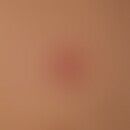DefinitionThis section has been translated automatically.
Complicative form of rosacea occurring after long-term therapy of rosacea with topical or systemic antibiotics with primary action against Gram-positive pathogens. This therapy leads to the selection of Gram negative pathogens.
ClinicThis section has been translated automatically.
The clinical picture is characterized by pustular formations (picture of Gram-negative folliculitis) on newly formed or already existing extensive erythema. There is no clinical difference to rosacea papulopustulosa. However, since the treatment regimen is different, a distinction to (Gram-positive) rosacea papulopustulosa is necessary.
DiagnosisThis section has been translated automatically.
Detection of Gram-negative pathogens such as: Klebsiellen, Proteus, E.coli, Acinetobacter and Pseudomonas spp.
LiteratureThis section has been translated automatically.
- Jansen T (1994) Gram-negative folliculitis as an accompanying complication of rosacea. Nude Dermatol 20: 381-384
- Reinholz M et al,(2016) Pathogenesis and Clinic of Rosacea al Key to Symptom-Oriented Therapy. J Dtsch Dermatol 14: 4-16
Disclaimer
Please ask your physician for a reliable diagnosis. This website is only meant as a reference.



